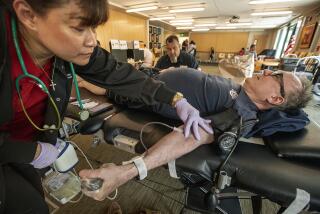Drive Holds Hope for Ailing Boy
- Share via
Up to 400 people are being sought for a bone marrow-typing drive today in an effort to find a donor for a 10-year-old Rancho Penasquitos boy with a fatal blood disorder.
An earlier screening of 630 people produced no matches for Kyle Varonfakis, who was diagnosed at the age of 4 with a blood disorder that causes bone marrow failure, said Lynn Stedd, spokeswoman for the San Diego Blood Bank.
For the past year, Kyle, a student at Sunset Hill Elementary School, has been receiving monthly blood transfusions because his bone marrow is not producing enough oxygen-carrying, red blood cells, Stedd said. No one in Kyle’s family is a matching donor.
Through bake sales, carnivals and other fund-raisers, the family has collected nearly $12,000 to pay for the typing drive, said Kyle’s mother, Debbie Poggioli.
Testing of potential donors is not covered by the family’s medical insurance, she said.
Up to 400 people can be tested at today’s screening, which will be held from 9 a.m.-2 p.m. at Clairemont Emmanuel Baptist Church, 2610 Galveston St., in Clairemont.
Although an earlier drive did not produce a donor for Kyle, it did provide several potential donors for other patients, she said. The chances of a donor matching Kyle’s blood marrow are 1 in 20,000.
Blood samples will be taken from potential donors, who must be from 18 to 55 years old and in good health with no history of asthma, cancer or heart or circulatory disease, Stedd said.
The results of the typing will be entered into the National Marrow Donor Program, which maintains a computerized registry for potential donors, she said.
The program will perform a computer check to see if any of the marrow types match Kyle’s or any bone marrow patient across the country.
If additional testing confirms the match, the donor will be admitted to either Children’s Hospital or UC San Diego Medical Center for an overnight stay at no cost, Stedd said.
Under anesthesia, the bone marrow is removed from the donor’s pelvic bone with a long needle and then injected into a vein in the recipient.
If the procedure is successful, the marrow finds its way inside the patient’s bone and begins producing red blood cells, she said.
More to Read
Sign up for Essential California
The most important California stories and recommendations in your inbox every morning.
You may occasionally receive promotional content from the Los Angeles Times.













